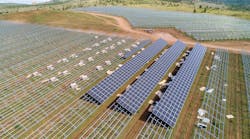Planned utility-scale solar power projects are seeing installation delays, with less than half of the planned capacity coming online over the first part of 2022, according to a report compiled by the U.S. Department of Energy’s Energy Information Administration.
Renewable power developers planned to install 17.8 GW of utility-scale photovoltaic solar capacity this year, according to DOE data, but over the first half of 2022, less than half, or 4.2 GW, came online.
In total, some 20% of planned solar photovoltaic capacity was delayed. Preliminary EIA data show that an average of 4.4 GW was delayed every month from January through June of this year. This can be compared with 2.6 GW in monthly delays over the same period in 2021.
According to the EIA, most of the projects to come online in the next year and a half are in the construction phase. There are nearly 2 GW of solar capacity currently under construction and now under delay. These are still slated to come online later this year.
Another 1.7 GW of under-construction projects will be pushed into next year.
According to the EIA report, most reported delays are for six months or less. The report does not delve into the specific causes of the delays that far, but it does note that world economic factors, such as supply chain difficulties, worker shortages and the high cost of component goods are limiting factors on the solar power industry.
Other factors specific to the solar power sector, including trade tariffs as well as obtaining the necessary siting and permitting, are slowing the pace of new solar array installation.
For example, in February 2022, tariffs against Chinese-imported crystalline silicon solar materials were extended by the U.S. government, raising the tariff quota from 2.5 GW to 5 GW. Bifacial panels were not included in this duty extension.
The U.S. Department of Commerce in April launched an “anti-dumping circumvention investigation” of solar cells and components from Southeast Asia, including Vietnam, Cambodia, Malaysia and Thailand. The logic for this move, according to the DOC, is that these countries obtain their components from China and would be subject to tariffs otherwise.
Solar components originating in Asian countries have been subject to these “anti-dumping” trade regulations since the Obama administration, carrying through the Trump administration to today, an extension of the sometimes-difficult relationship between U.S. and Chinese socio-economic spheres of influence.
Through a June executive action meant to speed up solar power deployment, President Joe Biden slackened such import duties for solar modules and cells for a two-year period. The White House simultaneously used the Defense Production Act to boost U.S.-based production of solar modules.
Overall, energy production declined by record amounts since 2020, according to the EIA, mostly as a result of contracting economic activity.
“U.S. renewable energy production increased by less than 1% in 2020, as solar production increased by 19% and wind by 13%, but biofuels fell by 10% and hydropower by 2%. Hydroelectricity generation in California fell by 45% in 2020, the largest decline of any state, mostly as a result of extensive drought,” according to an August 8 EIA report.


